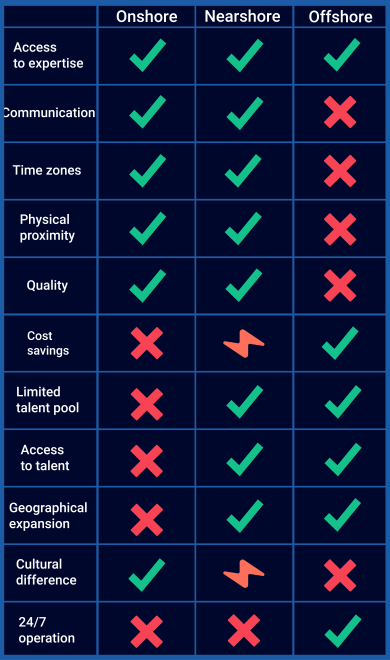Onshore, Nearshore, Offshore: What is the Difference?
Onshore, nearshore, and offshore are common concepts in the world of IT. However, it is not always completely clear what these terms mean and what the differences are. Although the terms are broadly applicable in different industries, in this blog post we focus on their meaning within IT software development.
Before we can explain the difference between these terms, we must first look at what the similarities are. In all three cases, it concerns outsourcing to an external party. The terms refer to different ways of outsourcing. The difference lies in the location of the outsourcing team relative to the company outsourcing the services.
Onshore
Onshore outsourcing means that a company outsources its IT activities to a partner within the same country. This means the company and the service provider operate in the same time zone and usually speak the same language.
Advantages of onshore outsourcing
- Access to expertise: Companies can access specialized skills and technologies that may not be available internally.
- Communication: No language barriers or cultural differences facilitate smoother communication
- Time zones: Operating in the same time zone ensures faster responses and easier coordination.
- Physical proximity: It is easy for both parties to meet and collaborate on-site.
- Quality: Often higher quality and adherence to local regulations and standards.
- Costs: Generally more expensive than nearshore or offshore outsourcing due to higher local wages and operational costs.
- Limited talent pool: The available talent pool may be limited compared to a global search.
Nearshore outsourcing means that a company outsources its software development to a partner in a nearby country, often in the same or a similar time zone. For European companies, this could be a country in Eastern Europe.
Advantages of nearshore outsourcing
- Access to expertise: Companies can access specialized skills and technologies that may not be available internally.
- Communication: Fewer cultural and language differences than with offshore teams, making communication easier.
- Time zones: Minimal time zone differences allow for regular interaction and quick problem-solving.
- Physical proximity: It is relatively easy for both parties to meet.
- Quality: Often higher quality due to similar regulations and standards.
- Access to talent: You gain access to a vast talent pool, especially in countries known for their IT expertise.
- Cost savings: Generally cheaper than onshore collaborations.
- Geographical expansion: A nearshore team can better understand local requirements and preferences, acting as a gateway to new markets.
Disadvantages of nearshore outsourcing
- Costs: Although cheaper than onshore, it can still be more expensive than offshore teams.
- Cultural differences: Although less significant than with offshore, there can still be cultural differences that impact collaboration.
Offshore
Offshore outsourcing means that a company outsources its IT activities to a partner in a distant, often overseas country. For a European company, this could be India or the Philippines.
Advantages of offshore outsourcing
- Access to expertise: Companies can access specialized skills and technologies that may not be available internally.
- Access to talent: A vast talent pool, especially in countries known for their IT expertise.
- Cost savings: The largest cost savings, as wages in many offshore countries are significantly lower.
- Geographical expansion: An offshore team can better understand local requirements and preferences, acting as a gateway to new markets.
- 24/7 operations: Due to time zone differences, companies can achieve a 24/7 work cycle.
Disadvantages of offshore outsourcing
- Communication: Possible language and cultural barriers can complicate communication.
- Time zones: Large time differences can make coordination difficult and cause communication delays.
- Physical proximity: It is challenging for both parties to meet.
- Quality: Differences in quality standards and regulations can lead to inconsistencies in the final product.
- Cultural differences: There can be cultural differences that impact collaboration.

Why outsource your software development?
As we have seen, each form of outsourcing has its own pros and cons. But why do companies choose to outsource software development? Common reasons include:
- Cost savings: Outsourcing can help reduce operational costs.
- Access to expertise: Companies can access specialized skills and technologies that may not be available internally.
- Flexibility: Outsourcing provides the flexibility to scale up or down quickly depending on project needs and collaboration partner.
- Risk diversification: By combining onshore, nearshore, and/or offshore teams, you can better spread risks and be more resilient to unexpected issues or disruptions.
Conclusion
When choosing between onshore, nearshore, and offshore outsourcing for IT software development, companies need to consider their specific needs, budget, and the nature of their projects. Each form of outsourcing has its own pros and cons that should be carefully evaluated to make the best choice. By making an informed decision, companies can not only save costs but also enhance their productivity and innovation capabilities.
Let's plan a meeting!
"*" indicates required fields